Effects of Printing Parameters on Properties of FDM 3D Printed Residue of Astragalus/Polylactic Acid Biomass Composites
Abstract
1. Introduction
2. Materials and Methods
2.1. Materials and Reagents
2.2. Production of FDM Filaments
2.3. Specimens Manufacturing
2.4. Measurement and Characterization
2.4.1. Mechanical Testing
2.4.2. Morphological Observation
2.4.3. Melt Flow Rate (MFR)
2.4.4. Thermogravimetric Analysis (TGA)
2.4.5. Differential Scanning Calorimetry
2.4.6. Wettability
3. Results and Discussion
3.1. Mechanical Properties
3.2. Flow Ability
3.3. Thermal Stability
3.4. Melting and Crystallization Behavior
3.5. Wettability
4. Conclusions
- (1)
- The mechanical properties could be improved when the printing temperature was increased from 200 °C to 220 °C or the filling density was increased from 60% to 100%; However, the properties would be decreased when the printing speed was increased from 50 mm/s to 70 mm/s, or the printing thickness was increased from 0.1 mm to 0.2 mm. When the effects of deposition angles on the mechanical properties were concerned, the specimen at a printing angle of 0° has the greatest mechanical properties, which were 22.63 MPa, 292.80 MPa, 102.84 MPa, and 16,910.96 MPa respectively for the tensile strength, tensile modulus, flexural strength, and flexural modulus.
- (2)
- The thermal stability of the FDM 3D printed PLA/ROA composite specimens could be improved either by increasing the printing temperature and the filling density or by reducing the printing speed and the printing thickness. The specimen printed at a deposition angle of 0° was more thermally stable than those printed at a deposition angle of 45° or 90°, but not remarkably.
- (3)
- The melting and crystallization behavior of the FDM 3D-printed PLA/ROA composite specimens was little affected by the printing parameters. The glassy transition temperature of each specimen was all around 62.5 °C, the cold crystallization temperature of each specimen was generally at around 118 °C, and the melting endotherm of each sample displayed two melting peaks at around 151 and 158 °C.
- (4)
- All the printed specimens are hydrophilic; the wettability of the specimens would be improved with the increase of the printing speed, the printing thickness, and the deposition angle, or the decrease of the printing temperature and the filling density. Among all the parameters, the printing speed could affect the wettability of the sample the most significantly.
Author Contributions
Funding
Institutional Review Board Statement
Informed Consent Statement
Data Availability Statement
Conflicts of Interest
Sample Availability
References
- Zhang, Q.; Cai, H.; Zhang, A.; Lin, X.; Yi, W.; Zhang, J. Effects of lubricant and toughening agent on the fluidity and toughness of poplar powder-reinforced polylactic acid 3D printing materials. Polymers 2018, 10, 932. [Google Scholar] [CrossRef] [PubMed]
- Wang, P.; Zou, B.; Ding, S.; Li, L.; Huang, C. Effects of FDM-3D printing parameters on mechanical properties and microstructure of CF/PEEK and GF/PEEK. Chin. J. Aeronaut. 2020, 34, 236–246. [Google Scholar] [CrossRef]
- Yao, T.; Ye, J.; Deng, Z.; Zhang, K.; Ma, Y.; Ouyang, H. Tensile failure strength and separation angle of FDM 3D printing PLA material: Experimental and theoretical analyses. Compos. Part B 2020, 188, 107894. [Google Scholar] [CrossRef]
- Marie-Joo, L.G.; Stefan, H.; Dawn, S.; Beatrix, T.; Evamaria, G.; Abdellatif, B.; Claire, M.L. Influence of rice husk and wood biomass properties on the manufacture of filaments for Fused Deposition Modelling. Front. Chem. 2019, 7, 735. [Google Scholar]
- Duigou, A.L.; Castro, M.; Bevan, R.; Martin, N. 3D printing of wood fiber composites: From mechanical to actuation functionality. Mater. Des. 2016, 96, 106–114. [Google Scholar] [CrossRef]
- Badouard, C.; Traon, F.; Denoual, C.; Mayer-Laigle, C.; Paës, G.; Bourmaud, A. Exploring mechanical properties of fully compostable flax reinforced composite filaments for 3D printing applications. Ind. Crops Prod. 2019, 135, 246–250. [Google Scholar] [CrossRef]
- Duigou, A.L.; Barbé, A.; Guillou, E.; Castro, M. 3D printing of continuous flax fiber reinforced composites for structural applications. Mater. Des. 2019, 180, 107884. [Google Scholar] [CrossRef]
- Farah, S.S.; Mohamed, T.H.S.; Syafiqah, N.A.S.; Mohammad, J.A.; Rahim, A.T.; Adi, A.B.; Ain, U.M.S. Fatigue and impact properties of 3D printed PLA reinforced with kenaf particles. J. Mater. Res. Technol. 2022, 16, 461–470. [Google Scholar]
- Cheng, P.; Wang, K.; Chen, X.; Wang, J.; Peng, Y.; Ahzi, S.; Chen, C. Interfacial and mechanical properties of continuous ramie fiber reinforced biocomposites fabricated by in-situ impregnated 3D printing. Ind. Crops Prod. 2021, 170, 113760. [Google Scholar] [CrossRef]
- Edgar, A.F.; Yael, R.E.; Perla, I.A.L. Characterization of 3D printing on jute fabrics. Polymers 2021, 13, 3202. [Google Scholar]
- Liu, H.; He, H.; Peng, X.; Huang, B.; Li, J. Three-dimensional printing of poly(lactic acid) bio-based composites with sugarcane bagasse fiber: Effect of printing orientation on tensile performance. Polym. Adv. Technol. 2019, 30, 910–922. [Google Scholar] [CrossRef]
- Long, H.; Wu, Z.; Dong, Q.; Shen, Y.; Zhou, W.; Luo, Y.; Zhang, C.; Dong, X. Mechanical and thermal properties of bamboo fiber reinforced polypropylene/polylactic acid composites for 3D Printing. Polym. Eng. Sci. 2019, 59, E247–E260. [Google Scholar] [CrossRef]
- Yu, W.; Dong, L.; Lei, W.; Shi, J. Rice straw powder/polylactic acid biocomposites for three-dimensional printing. Adv. Compos. Lett. 2020, 29, 1–8. [Google Scholar] [CrossRef]
- Ma, S.; Kou, L.; Zhang, X.; Tan, T. Energy grass/polylactic acid composites and pretreatments for additive manufacturing. Cellulose 2020, 27, 2669–2683. [Google Scholar] [CrossRef]
- Tugce, T.; Volkan, K.; Eyup, S.T. Effects of the printing parameters on short-term creep behaviors of three-dimensional printed polymers. J. Appl. Polym. Sci. 2019, 136, 47564. [Google Scholar]
- Nadir, A.; Mirko, K.; Jin, H.K.; Manja, K.K. Effect of printing layer thickness on water absorption and mechanical properties of 3D-printed wood/PLA composite materials. Int. J. Adv. Manuf. Technol. 2019, 102, 2195–2200. [Google Scholar]
- Farah, S.S.; Mohamed, T.H.S.; Syafiqah, N.A.S.; Mohammad, J.A.; Rahim, A.T.; Adi, A.B.; Ain, U.M.S. Physical, thermal and tensile behaviour of 3D printed kenaf/PLA to suggest its usability for ankle-foot orthosis–a preliminary study. Rapid Prototyp. J. 2022, 28, 8. [Google Scholar] [CrossRef]
- Zhu, Y.; Gao, Y.; Jiang, J.; Gu, H.; Lv, S.; Ni, H.; Wang, X.; Jia, C. Study on effects of FDM 3D printing parameters on mechanical properties of polylactic acid. IOP Conf. Ser. Mater. Sci. Eng. 2019, 688, 033026. [Google Scholar]
- Rebenaque, A.G.; González-Requena, I. Study of bending test of specimens obtained through FDM processes of additive manufacturing. Procedia Manuf. 2019, 41, 859–866. [Google Scholar] [CrossRef]
- Gui, Z.; Lu, C.; Cheng, S. Comparison of the effects of commercial nucleation agents on the crystallization and melting behavior of polylactic. Polym. Test. 2013, 32, 15–21. [Google Scholar] [CrossRef]
- Yu, W.; Dong, L.; Lei, W.; Zhou, Y.; Pu, Y.; Zhang, X. Effects of rice straw powder (RSP) size and pretreatment on properties of FDM 3D-printed RSP/poly(lactic acid) biocomposites. Molecules 2021, 26, 3234. [Google Scholar] [CrossRef] [PubMed]
- Wang, L.; Gramlich, W.M.; Gardner, D.J. Improving the impact strength of poly(lactic acid) (PLA) in fused layer modeling (FLM). Polymer 2017, 114, 242–248. [Google Scholar] [CrossRef]
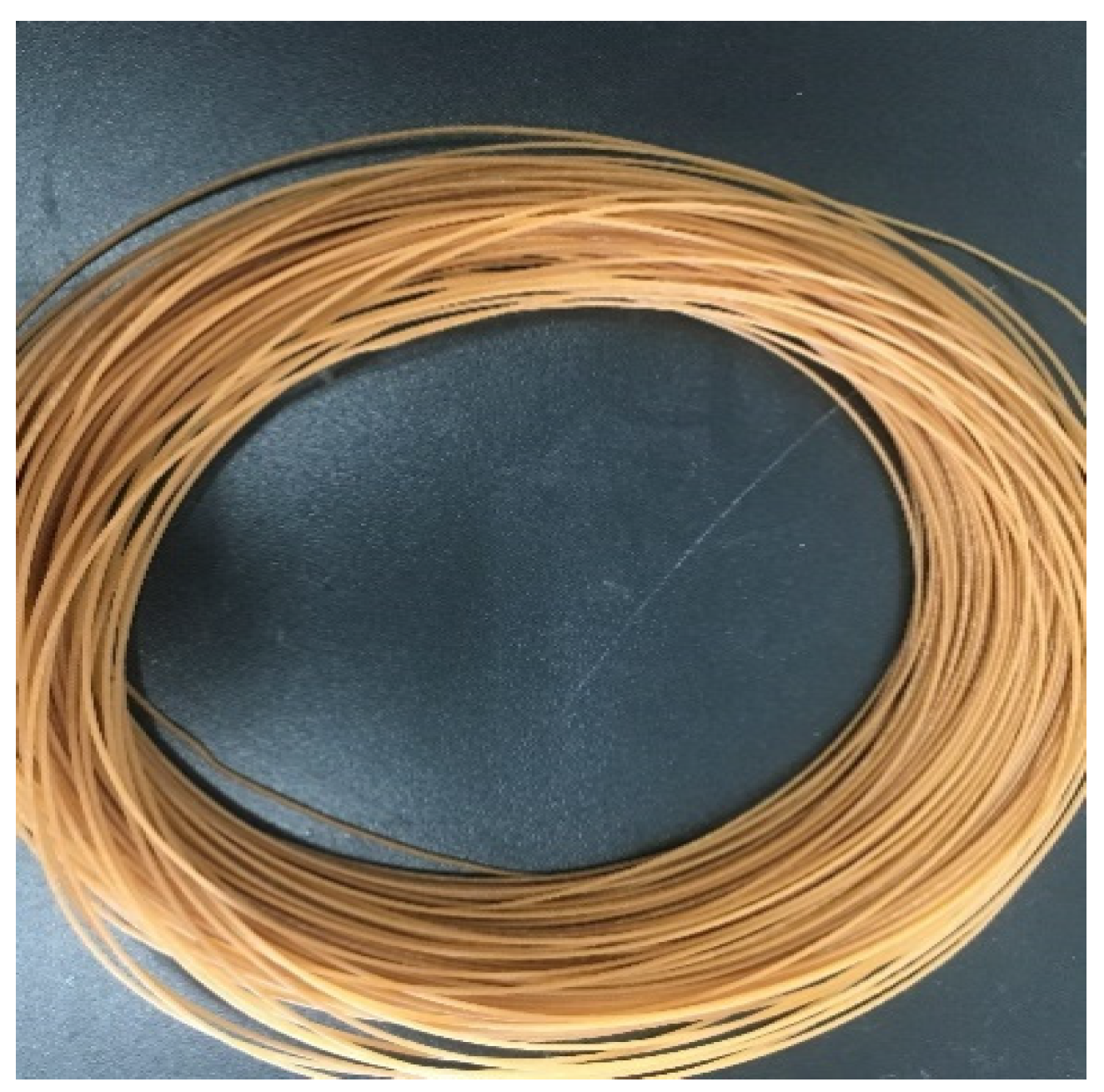




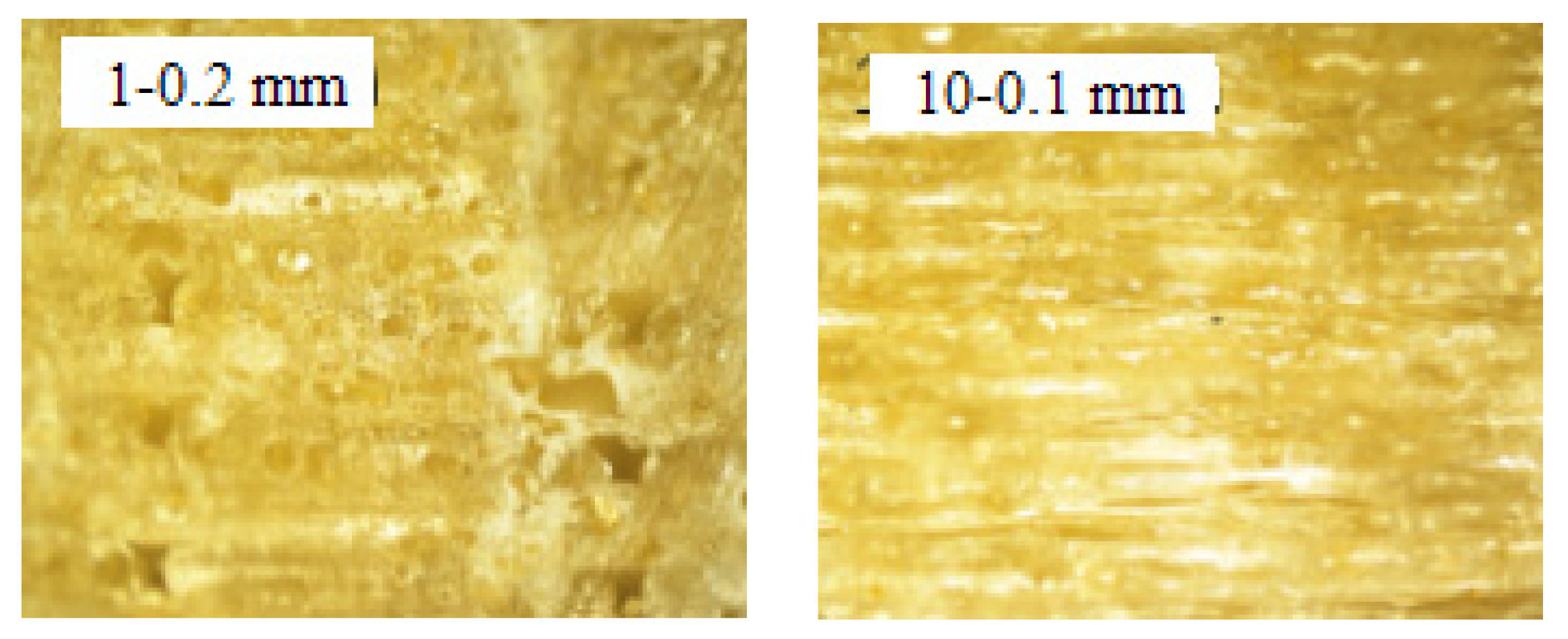

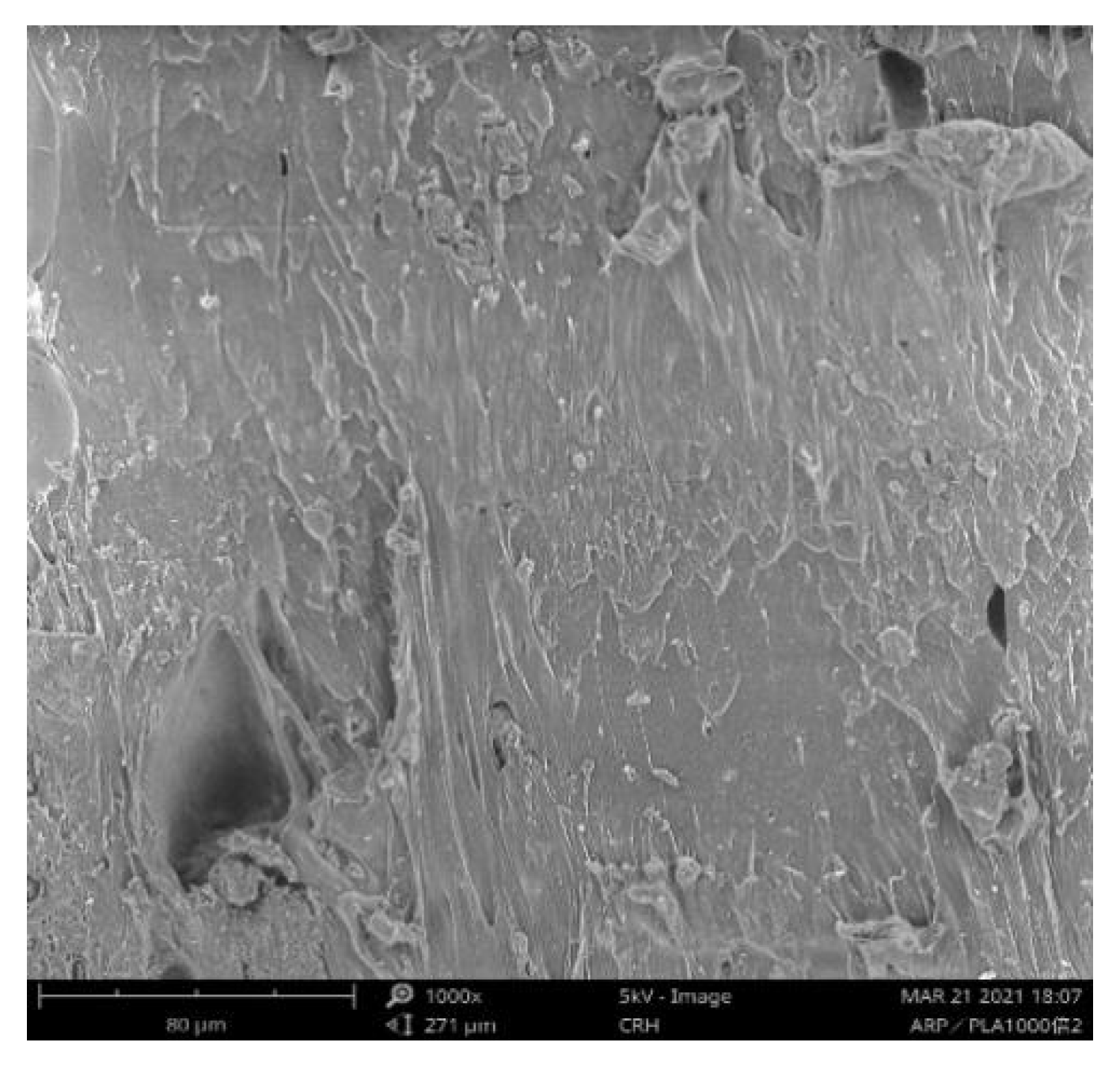
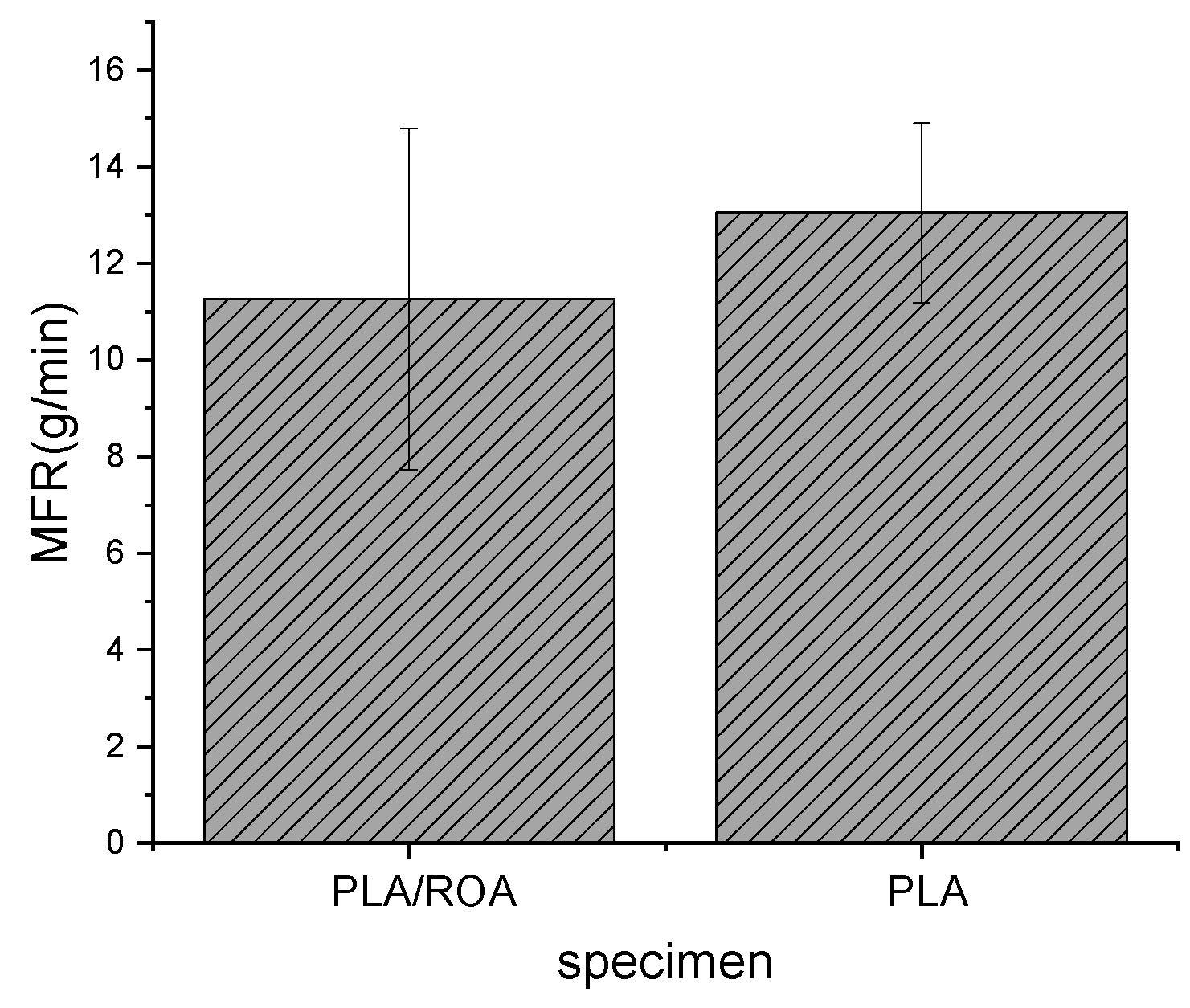
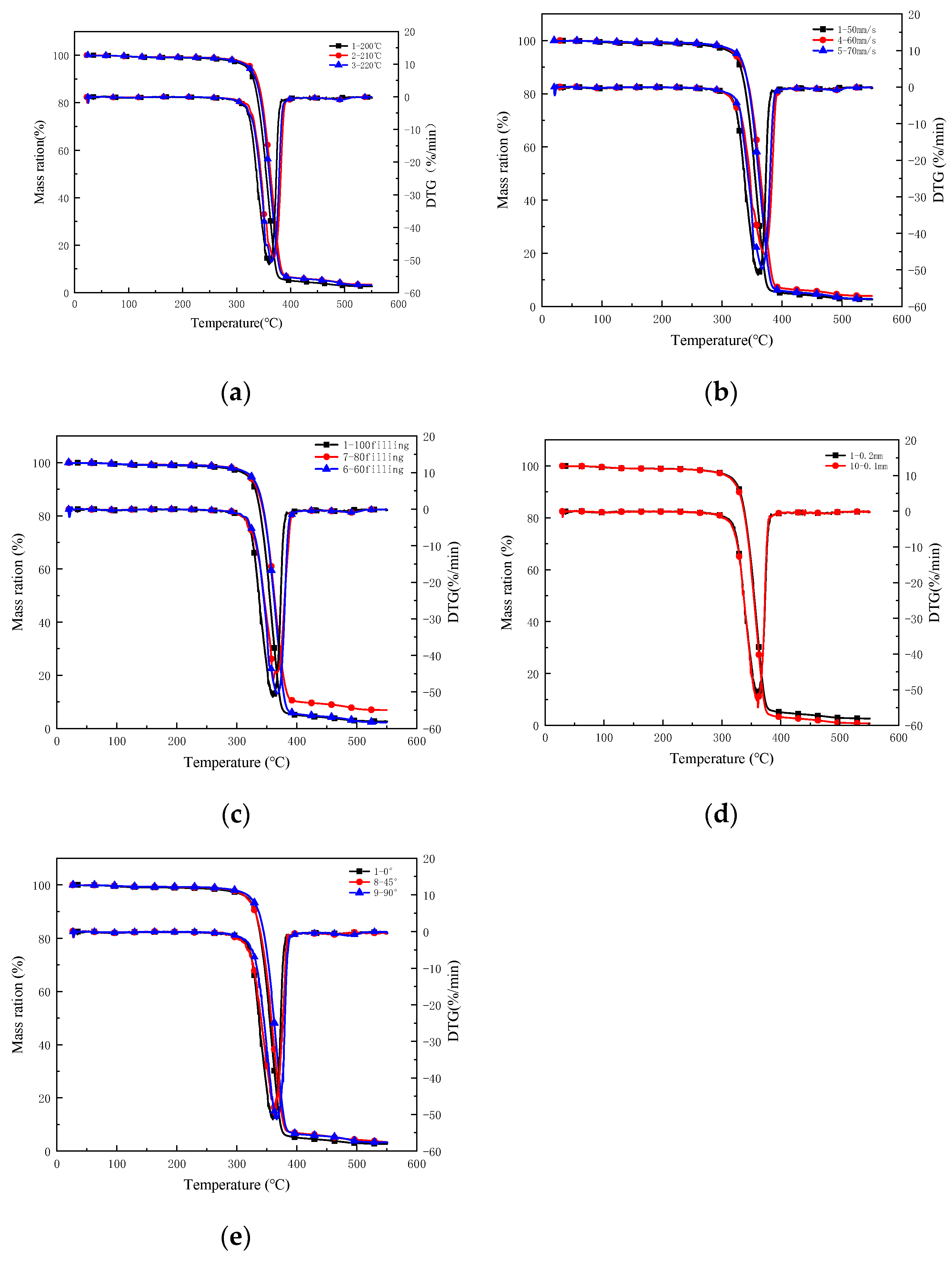



| Sample No. | Filling Density (%) | Deposition Angle (°) | Printing Speed (mm/s) | Printing Temperature (°C) | Printing Layer Thickness (mm) | Flexural Strength (MPa) | Flexural Modulus (MPa) | Tensile Strength (MPa) | Tensile Modulus (MPa) |
|---|---|---|---|---|---|---|---|---|---|
| 1 | 100 | 45 | 50 | 200 | 0.2 | 97.60 ± 4.25 | 16,406.04 ± 553.84 | 17.46 ± 1.28 | 234.27 ± 12.88 |
| 2 | 100 | 45 | 50 | 210 | 0.2 | 100.23 ± 9.21 | 16,799.14 ± 656.54 | 20.28 ± 2.46 | 265.92 ± 11.86 |
| 3 | 100 | 45 | 50 | 220 | 0.2 | 120.93 ± 9.68 | 17,333.35 ± 486.42 | 23.51 ± 2.88 | 316.75 ± 23.58 |
| 4 | 100 | 45 | 60 | 200 | 0.2 | 62.22 ± 6.53 | 13,545.13 ± 638.62 | 14.36 ± 1.12 | 162.21 ± 13.57 |
| 5 | 100 | 45 | 70 | 200 | 0.2 | 60.43 ± 5.46 | 10,820.75 ± 711.33 | 13.25 ± 1.02 | 154.62 ± 10.67 |
| 6 | 60 | 45 | 50 | 200 | 0.2 | 87.24 ± 5.96 | 14,373.35 ± 567.46 | 14.80 ± 1.86 | 206.73 ± 19.01 |
| 7 | 80 | 45 | 50 | 200 | 0.2 | 94.31 ± 8.62 | 15,878.05 ± 609.02 | 16.53 ± 1.08 | 215.26 ± 15.25 |
| 8 | 100 | 0 | 50 | 200 | 0.2 | 102.84 ± 9.22 | 16,910.96 ± 710.87 | 22.63 ± 2.12 | 292.80 ± 17.92 |
| 9 | 100 | 90 | 50 | 200 | 0.2 | 89.63 ± 7.03 | 15,908.66 ± 822.31 | 17.36 ± 2.56 | 221.13 ± 16.43 |
| 10 | 100 | 45 | 50 | 200 | 0.1 | 107.46 ± 8.88 | 17,547.12 ± 803.48 | 20.71 ± 2.62 | 279.70 ± 20.08 |
| Sample No. | Ti/°C | Tp/°C | W/% |
|---|---|---|---|
| 1 | 336.9 | 363.3 | 2.35 |
| 2 | 337.1 | 364.5 | 3.13 |
| 3 | 339.4 | 369.1 | 3.27 |
| 4 | 336.1 | 362.3 | 1.64 |
| 5 | 334.5 | 361.1 | 4.75 |
| 6 | 331.7 | 360.1 | 2.69 |
| 7 | 334.9 | 361.9 | 2.77 |
| 8 | 337.8 | 364.1 | 5.15 |
| 9 | 337.6 | 363.8 | 2.43 |
| 10 | 339.6 | 369.1 | 3.44 |
| Sample No. | Tg/°C | Tcc/°C | Tm/°C | ΔHcc/(J/g) | ΔHm/(J/g) | Χc/% |
|---|---|---|---|---|---|---|
| 1 | 62.4 | 117.6 | 150.7 | −26.30 | 27.90 | 1.9 |
| 2 | 62.6 | 118.1 | 150.9 | −23.92 | 26.60 | 3.2 |
| 3 | 62.5 | 117.8 | 150.5 | −27.58 | 29.19 | 2.0 |
| 4 | 62.5 | 117.9 | 150.7 | −25.61 | 27.37 | 2.1 |
| 5 | 62.5 | 118.2 | 150.8 | −24.54 | 28.11 | 4.3 |
| 6 | 62.7 | 118.8 | 151.1 | −25.07 | 25.78 | 0.8 |
| 7 | 62.1 | 118.7 | 150.8 | −26.27 | 26.03 | 0.3 |
| 8 | 62.4 | 117.9 | 150.6 | −24.65 | 27.32 | 3.2 |
| 9 | 62.6 | 117.6 | 150.6 | −28.61 | 30.56 | 2.4 |
| 10 | 62.5 | 117.5 | 150.6 | −24.31 | 26.64 | 2.8 |
| Sample No. | 1 | 2 | 3 | 4 | 5 | 6 | 7 | 8 | 9 | 10 |
|---|---|---|---|---|---|---|---|---|---|---|
| Contact angle/° | 78.2 ± 0.5 | 79.1 ± 0.4 | 80.0 ± 0.6 | 73.7 ± 0.5 | 70.5 ± 0.3 | 76.6 ± 0.6 | 77.4 ± 0.5 | 79.3 ± 0.5 | 78.0 ± 0.8 | 80.1 ± 0.6 |
Publisher’s Note: MDPI stays neutral with regard to jurisdictional claims in published maps and institutional affiliations. |
© 2022 by the authors. Licensee MDPI, Basel, Switzerland. This article is an open access article distributed under the terms and conditions of the Creative Commons Attribution (CC BY) license (https://creativecommons.org/licenses/by/4.0/).
Share and Cite
Yu, W.; Shi, J.; Sun, L.; Lei, W. Effects of Printing Parameters on Properties of FDM 3D Printed Residue of Astragalus/Polylactic Acid Biomass Composites. Molecules 2022, 27, 7373. https://doi.org/10.3390/molecules27217373
Yu W, Shi J, Sun L, Lei W. Effects of Printing Parameters on Properties of FDM 3D Printed Residue of Astragalus/Polylactic Acid Biomass Composites. Molecules. 2022; 27(21):7373. https://doi.org/10.3390/molecules27217373
Chicago/Turabian StyleYu, Wangwang, Jianan Shi, Liwei Sun, and Wen Lei. 2022. "Effects of Printing Parameters on Properties of FDM 3D Printed Residue of Astragalus/Polylactic Acid Biomass Composites" Molecules 27, no. 21: 7373. https://doi.org/10.3390/molecules27217373
APA StyleYu, W., Shi, J., Sun, L., & Lei, W. (2022). Effects of Printing Parameters on Properties of FDM 3D Printed Residue of Astragalus/Polylactic Acid Biomass Composites. Molecules, 27(21), 7373. https://doi.org/10.3390/molecules27217373






